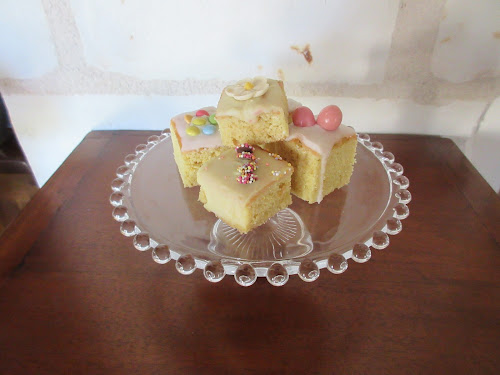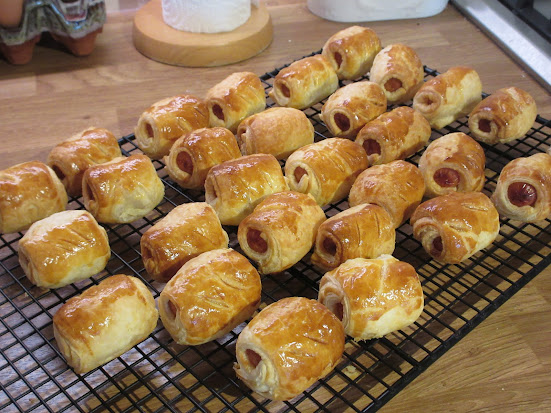
The weather on Easter Sunday this year was especially foul. Cold, grey and with persistent rain that was occasionally horizontal. Most other options for entertainment were cancelled so it was a perfect day for baking a cake! A rummage in the kitchen cupboards revealed that I had all the necessary ingredients to make a Simnel cake, including a pack of marzipan.
This is the first Simnel cake I have ever made in my whole life.
Usually I would make a chocolate cake for Easter (
see here).
A Simnel cake is a traditional cake for Easter, a rich fruit cake. It's not quite as rich and dense as a Christmas cake but more so than an everyday fruit cake, containing a lot of dried fruit and some mixed spice. The secret ingredient is the layer of marzipan, or almond paste, contained inside the cake itself. This was only just visible once the cake was baked.
I adapted a Mary Berry recipe using the fruit I had in stock. Shops are not open in France on Sunday afternoons and in any case the weather was so foul that I would rather not venture out! It's an all-in-one kind of recipe, no separate creaming of butter and sugar needed, but was quite a hefty amount of ingredients. Consequently I used my Kenwood stand mixer to beat it as I didn't quite have the muscle power to do it with a wooden spoon and I thought my little hand held mixer would struggle.
It was a delicious cake, very moist and spicy and I would definitely make it again. It seems a shame to only have one a year - rather like the Christmas cake! Having never made one before I had nothing to compare it with except that my friend Gaynor makes one every Easter, using a
Felicity Cloake recipe, which is lovely.
Most recipes suggest that the top marzipan layer and the eleven balls (representing the eleven loyal disciples) should be browned slightly, either under a grill or using a cook's blowtorch. However, I had spotted an alternative method of decoration as above - simply pressing a mini egg into each ball then dusting with icing sugar. You can of course decorate it any way you like, with eggs, flowers, chicks, chocolate or whatever takes your fancy. There are plenty of ideas on the internet.
Ingredients
225g baking spread (spreadable butter) straight from the fridge
225g light muscovado (or light soft brown) sugar
225g self raising flour
115g glacé cherries
175g sultanas
50g raisins
115g currants
115g ready to eat dried apricots
55g candied peel (mine was just orange peel) chopped
zest of 2 lemons
4 large eggs
2 level tsp mixed spice (or quatre épices)
Also
1 pack (roughly 500g) marzipan
1-2 tblsp apricot jam
11 mini eggs
icing sugar for dusting
Method
Begin by cutting the cherries into quarters, rinse well under running water to remove the syrup, tip onto kitchen paper and pat dry. Snip or chop the apricots into small dice.
Preheat the oven to 150C / 130 fan / gas mk 2. Grease a 20cm deep round cake tin and line the base and sides with baking paper.
Put all the fruit and other cake ingredients into a large bowl and beat together well by hand or use a stand food mixer.
Spoon roughly half of the mixture into the tin and level the top.
Divide the marzipan into three roughly equal portions. Roll out one of them into a 20cm circle. It doesn't matter if the edges are a bit untidy as they won't be seen. Lay on top of the cake mixture in the tin.
Spoon the other half of cake mixture on top of the marzipan and level the top again.
Bake for 2½ hours until the cake is risen, brown and firm. Check after an hour or so and cover with a circle of foil if it's already quite brown to avoid it becoming scorched.
When cooked, remove from the oven and leave in the tin for 10 minutes. Then turn out carefully to finish cooling on a wire rack, removing all the baking paper.
Roll out another portion of the marzipan to a 20cm circle to fit the top of the cake, making the edges more tidy this time. If you are using a tin with a loose bottom you can use it as a template.
Brush the top of the cooled cake with apricot jam. (You can sieve it to remove lumps of fruit if you wish, or use apricot glaze which is smooth and lump free.) Lay the second circle of marzipan on the top.
Crimp the edges of the marzipan to create a fluted effect and arrange the balls evenly around the edge. Dab the bottom of each one with a little apricot jam to make them stick. Using your finger or the handle of a wooden spoon, push a dent into each ball and insert a small mini egg. Dust with icing sugar.
Cuts into 11 generous slices or at least 15 regular slices if you remove a ball or two as you go round! (You can compensate the unlucky recipient of a slice without a ball with another mini egg!)





















